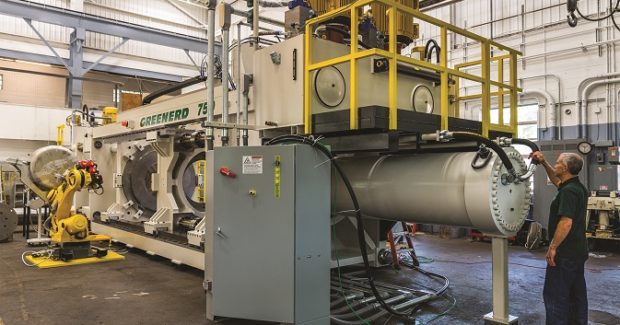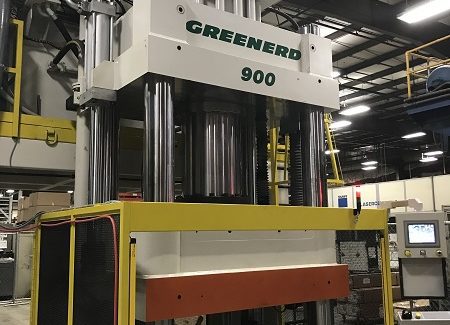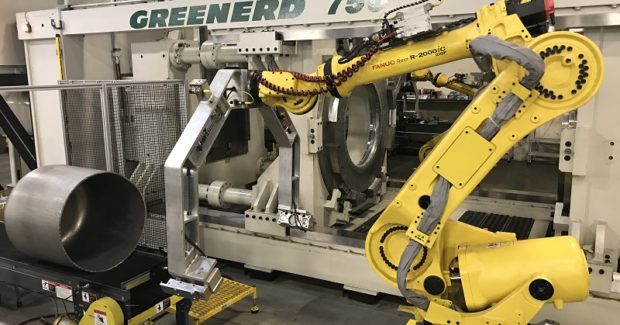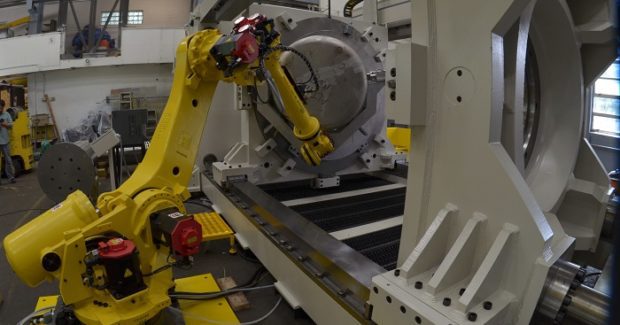Top Ten Reasons to Go Hydraulic
To meet the growing demands for smaller lots and varied applications, hydraulic press technology is faster and more reliable than ever to improve press room productivity and the bottom line.
Posted: June 12, 2019
Today’s hydraulic presses are faster and more reliable than ever as the technology has gone through significant changes and refinements. Improvements in seals, more efficient pumps, and stronger hoses and couplings have virtually eliminated leaks and minimized maintenance. Taking a serious look at your current applications and press processes is well worth the time and effort. Check out the top ten benefits of hydraulic presses below and perhaps you may find it’s time to get serious about going hydraulic:
1. Save Time During Set-Up and Changeovers
Hydraulic presses can save time during set-up and changeovers. Because the full power of a hydraulic press can be delivered at any point in the stroke, there is no need to determine the exact location of maximum tonnage. This means hydraulic presses eliminate the very tricky, time-consuming task of setting the stroke on a mechanical press. Users of hydraulic presses are often amazed at how quickly they can change dies and get on with a new job during changeovers.
2. Flexibility for a Wide Range of Applications
Hydraulic presses are becoming more and more common on high volume production lines. A single hydraulic press can do a wide variety of jobs within its tonnage range. Commonly seen applications include deep draws, shell reductions, urethane bulging, forming, blank and pierce, stake, punch, press fits, straightening, and assembly. They are also used for powdered metal forming, abrasive wheel forming, bonding, broaching, ball sizing, plastic and rubber compression, and transfer molding. Programmable logic controllers (PLCs) and other electronic-based controls have improved their speed and flexibility. With new computer interfaces and monitoring, hydraulic presses are now widely used in advanced computer-integrated manufacturing systems. The following jobs, along with hundreds of others, are now being done on hydraulic presses:
- Electric motor manufacturers assemble motor shafts to rotors, compress laminations, and press cores into housing.
- Automotive manufacturers press tiny shafts into water pumps, assemble shock absorbers, blank and form diaphragms, and stake disc brakes together.
- Jewelers coin Boy Scout pins.
- Frozen fish blocks are shaped for more efficient processing.
- Aerospace companies form tough titanium housings.
- Tuba bells and cymbals are shaped in huge forming presses.
- Hardened road grader blades and machine ways are straightened.
- Hollowware manufacturers blank and draw brass bowls automatically from coiled stock.
- Computer disc shafts are pressed into precision bearings.
3. Full Power at Any Point in the Stroke
The full power of a hydraulic press can be delivered at any point in the stroke. Advantages? In drawing operations, for example, you have the full power of the press available at the top of the stroke. You don’t have to buy a 200 ton press to get 100 tons throughout the stroke. Other advantages are faster set-ups and no time-consuming job of adjusting the stroke nut on the slide to accommodate different dies.
4. Built-in Overload Protection
Hydraulic presses provide built-in overload protection. For example, a 100 ton hydraulic press will exert only the tonnage you have specified – 100 tons pressure if you have it set for 100 tons, or less, if you have set it for less – no matter what mistakes you make in set-up. This eliminates worries about overloading or breaking the press or smashing a die. When a hydraulic press reaches its set pressure, that’s all the pressure there is. The relief valve opens at that limit and there is no danger of overload. This built-in overload protection applies to the tools, too. If they are built to withstand a certain load, there is no danger of damaging them because of overloading. Tools can be sized to withstand the load of a particular job, not a particular press. The pressure of the press can be set down to suit the job. The lack of impact, shock, and vibration promotes longer tool life.
5. Much Lower Operating Costs
Hydraulic presses are relatively simple and provide a significant cost advantage over mechanical presses in comparable sizes. The numbers of moving parts are few and these are fully lubricated in a flow of pressurized oil. Breakdowns are infrequent, but when they do occur, are usually minor. Typical routine maintenance items may include replacements of packing, solenoid coils, and occasionally a valve. Not only are these parts inexpensive, but they are also easily replaced without having to disassemble the entire machine. This allows for more up-time and lower maintenance costs.
6. Larger Capacities for Less Cost
It is easier and less expensive to buy certain kinds of capacity in hydraulic presses. Stroke lengths of 12 in, 18 in and 24 in are common. Extra stroke length is easy to provide. Open gap (daylight) can also be added without much additional cost. Similarly, larger table areas and small presses with big bed areas can be provided. Large 200 ton presses with relatively small beds are available; tonnage of the press doesn’t dictate what the bed size will be.
7. Greater Control
With a hydraulic press, the ram force, direction, speed, release of force, and the duration of pressure dwell can all be adjusted to fit a particular job. Jobs with light dies can be done with the pressure turned down. The ram can be made to approach the work rapidly, then shifted to a slower speed before contacting the work. This prolongs tool life. Timers, feeders, heaters, coolers, and a variety of auxiliary functions can be brought into the sequence to suit the job.
8. Noise Reduction
Fewer moving parts and the elimination of a flywheel reduce the overall noise level of hydraulic presses compared to mechanical presses. Properly sized and properly mounted pumping units meet and exceed current federal standards for noise, even with the pump under full pressure. Because each phase of the ram movement can be controlled, noise levels can also be controlled. A hydraulic ram can be programmed to pass through the work slowly and quietly.
9. Maximize Your Space
Hydraulic presses feature a compact design. A typical 20 ton hydraulic press is 8 ft high, 6 ft deep and 2 ft wide. A 200 ton press is only 10 ft high, 9 ft deep and a little over 3 ft wide. At 10X the capacity, the 200 ton press only takes up 50 percent more floor space, which means you can maximize your press room floor space with more streamlined machinery.
10. Safety First and Foremost
When improperly used, all machines are potentially dangerous. But because ram movements can be controlled with hydraulic presses, it’s easy to make it safe. Non-tie down, anti-repeat, dual palm button controls are used. The interlocking of guards, as well as other safety devices, is relatively easy because of the nature of a hydraulic press control system.
After a careful assessment, you may well find that hydraulic press technology is the system to improve productivity and your bottom line, not only in difficult economic conditions, but for the ever-growing demands for smaller lots and varied applications – a trend that will only increase in the future. For example, consider how using hydraulic press technology integrated with robotic machine tending, a metalformer realized an over 230 percent productivity increase. The shop was using several vertical presses to perform draws on heavy, 72 in diameter, 0.5 in thick, 80-100 lb aluminum blanks. Up to three operators had to facilitate moving the blanks in and out of the presses. Cranes were used for blank placement and part orientation. They installed a custom, complex double-moving platen Greenerd deep draw hydraulic press, fully integrated with two 6-axis FANUC robots that, in addition to load/ unload, prompt the press to perform multiple operations required to produce a heavy-duty high pressure cylinder tank.
The horizontal four-post gib-guided press has a 750 ton cylinder main ram (adjustable down to 150 tons) with a 350 ton cushion (adjustable down to 70 tons). The deep draw hydraulic press has a 108 in stroke capability and a 48 in draw. With the 350 ton cushion to clamp a blank between the main ram and the cushion platen, the main ram of 750 tons pushes the blank over a punch that is attached to the stationary platen and coins the part on the top before returning. The double-moving platen design allows the press to draw the long part at one speed and tonnage and, while still moving, switch to another speed and tonnage to coin the part properly. To retrieve the newly drawn part out of the press, a FANUC robot moves in between the double platens and, when in position, instructs the press when and at what velocity, to extract the part.
Thomas Lavoie is the applications manager at Greenerd Press & Machine Company, 41 Crown Street, PO Box 886, Nashua, NH 03031, 603-889-4101, Fax: 603-889-7601, www.greenerd.com.














